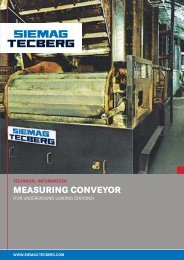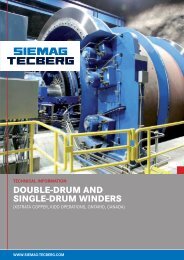TruckLift System
TI_27_Trucklift_e.pdf - Siemag Tecberg
TI_27_Trucklift_e.pdf - Siemag Tecberg
- No tags were found...
You also want an ePaper? Increase the reach of your titles
YUMPU automatically turns print PDFs into web optimized ePapers that Google loves.
Technical Information<br />
<strong>TruckLift</strong> <strong>System</strong><br />
(Innovative Transport Technology for Open Pit Mines)<br />
WWW.sieMaG-tecBerG.coM
Technical Information<br />
SIEMAG TECBERG <strong>TruckLift</strong><br />
Ore deposits close to the surface are generally<br />
developed by open pit mining. Due to the hardness<br />
of the rock, mining is usually carried out by means of<br />
drilling and blasting. Large excavators load the material<br />
directly onto big trucks which convey the uncrushed<br />
rock from the mine. Most of the rock is overburden<br />
which is transported to one or several dumps close<br />
to the mine. On the other hand, the ore is driven to a<br />
crusher close to the processing plant. Apart from the<br />
simple way the uncrushed material is handled, this form<br />
of conveyance has the advantage of the trucks being<br />
able to be flexibly driven to the varying loading points<br />
and also to be tipped at diverse points depending on<br />
actual requirements.<br />
When mining penetrates increasingly deeper, this<br />
mostly means that the mine takes some kind of funnel<br />
shape. The deeper the funnel, the greater the expense<br />
for transport. While the roads hardly change deep<br />
down in the mine as well as at the top, expenditure on<br />
the haulage incline increases drastically. On the one<br />
hand, the driving time is prolonged by the increasingly<br />
longer incline road and the relatively low driving speed<br />
of the trucks on this section. On the other hand,<br />
fuel consumption increases considerably, just as, in<br />
particular, does vehicle wear. This means that the part<br />
of transport on the incline is becoming an increasingly<br />
decisive cost factor.
SIEMAG TECBERG <strong>TruckLift</strong><br />
slope hoisting system<br />
To optimise transport while maintaining flexibility<br />
offered by truck transport, SIEMAG TECBERG has<br />
developed the <strong>TruckLift</strong> slope hoisting system which<br />
considerably accelerates and cheapens transport from<br />
the mine.<br />
The advantage lies in the transport time being curtailed<br />
by the difference in height being rapidly overcome.<br />
While the trucks move upwards at less than 3 m/s on<br />
a slope of 10 % at the maximum, a slope hoisting plant<br />
can overcome the mine’s natural angle of repose of<br />
over even 50° at 8 m/s. This means that a truck is<br />
hoisted to surface in only 2 minutes while driving on the<br />
haul road incline takes some 20 minutes (from 300 m<br />
depth, time for driving on and off the <strong>TruckLift</strong> platform<br />
included). Whereas one vehicle is on the slope with<br />
the <strong>TruckLift</strong> plant at one time, conventional haulage<br />
requires a large number of trucks only on the inclined<br />
part of the road for achieving the same transport<br />
volume. Thus the truck fleet can correspondingly be<br />
reduced.<br />
SIEMAG TECBERG has drawn up several studies to<br />
individually highlight this information for different<br />
projects. The studies concern the comparison between<br />
truck transport with a payload of 100 - 290 t in the<br />
conventional way over the incline haul road, and<br />
transport with these vehicles using the <strong>TruckLift</strong> slope<br />
hoisting plant.<br />
The <strong>TruckLift</strong> <strong>System</strong>:<br />
Transport capacity and economic viability<br />
The <strong>TruckLift</strong> <strong>System</strong> transport capacity depends<br />
mostly on the truck size and hoisting depth. Capacity<br />
can be starting with 4,000 t/h and being at 2,000 t/h<br />
at the final depth. With a conservatively calculated<br />
annual operational time of 7,500 hours, this means a<br />
transport capacity of 15 million tons at the final depth.<br />
Depending on the depth, the saving in number of trucks<br />
in operation increases up to 12 – or even more.<br />
Naturally what has to be ascertained is that initial<br />
investment for a slope hoisting plant is relatively high,<br />
whereas investments for new and replacement trucks<br />
only rise continuously. However, operational expenditure<br />
for trucks, comprising maintenance, spare parts and<br />
personnel costs for drivers as well as for fuel, is very<br />
high, making up considerably more costs compared to a<br />
slope hoisting plant, so that total costs quickly develop<br />
in favour of slope hoisting.<br />
Comparing the costs by the present value method<br />
using an interest rate of 10 % on future costs and<br />
considering an annual price increase of 3 %, investing in<br />
a slope hoisting plant usually pays off within less than<br />
five years. During a plant’s running time of 20 years,<br />
a volume of up to 60 % can be saved with regard to<br />
gradient transport.
SIEMAG TECBERG <strong>TruckLift</strong> slope hoisting<br />
technology<br />
The <strong>TruckLift</strong> <strong>System</strong> is designed for transport on the<br />
natural angle of repose of the open pit mine and can<br />
be lengthened for increasing depth. It is set up as a<br />
single conveyance plant with counterweight, providing<br />
maximum flexibility of the hoisting operation.<br />
It is designed for two or more loading points, one<br />
or more down in the mine and a second one above<br />
at a height appropriate for the purpose. Trucks are<br />
transported on a platform. Down in the mine, the fully<br />
laden trucks drive to the loading station, at which one<br />
vehicle drives onto the transport platform in each<br />
instance. The slope hoisting plant conveys the truck out<br />
of the mine to the upper loading station where it leaves<br />
the plant. The driver stays in his vehicle during hoisting<br />
so that no change of driver is necessary. At the upper<br />
loading station, an empty truck drives onto the platform<br />
for the downward trip immediately after the platform is<br />
free. In this way, the plant runs constantly loaded, each<br />
time a vehicle changes at the loading stations.<br />
The transport platform comprises the platform proper,<br />
on which the truck stops, with pavement, box profiles as<br />
lateral limits, as well as the pertinent sub-construction.<br />
This construction consists of a carrier which overcomes<br />
the offset angle between the horizontal vehicle and the<br />
roadway and where the ropes are hitched. Moreover, the<br />
running gears are attached here which undertake the<br />
carrying and guiding function on the travel path.<br />
The travel path is a concrete or steel construction,<br />
on which the rails for the transport platform and<br />
counterweight are attached. It has appropriate<br />
foundations in the rock. It is designed trough-shaped,<br />
as the counterweight runs under the transport platform.<br />
Rope rollers take over the carrier function for the ropes<br />
on the slope section.<br />
The counterweight is designed as a flat platform with a<br />
running gear to take up the plate weights. What is more,<br />
rope magazines are accommodated here, where on each<br />
some 25 m of rope length can be stored, enabling the<br />
transport distance to be lengthened without rope having<br />
to be changed.<br />
The transport platform and the counterweight are<br />
attached to 6 to 8 ropes and are powered by means of<br />
a multi-rope friction winder. The winder is appointed<br />
in a machine house above the top loading point, rope<br />
sheaves guiding the ropes appropriately. The motor is<br />
appointed in the driving pulley, since the winder is big<br />
enough with regard to diameter and width. The plant<br />
is designed for operation without tail ropes as weight<br />
compensation for the hoisting ropes. In this manner,<br />
there is no equipment necessary at the bottom end<br />
of the hoisting plant, as such equipment would be<br />
expensive to reinstall for a greater depth.<br />
The loading stations comprise the ramps and pertinent<br />
concrete construction in the area between the ramp<br />
and hoisting plant. Platform arrestors are provided at<br />
the loading points, which are run out when the transport<br />
platform arrives, ensuring that the transport platform<br />
is held in position when the load changes by the trucks<br />
arriving and departing. At the same time, this reduces<br />
the dynamic load on the ropes. When the bottom loading<br />
station is transferred, as a result of deeper mining<br />
progression, first of all the new ramps and the civil<br />
construction for the loading station are completed. All<br />
that has to be done now to move the loading station<br />
properly is to transfer the mechanical equipment,<br />
basically the arrestors, and to let out the ropes out of<br />
the magazines. This work can be done in a few shifts.<br />
Truck loading station
Economical Study for Specific Mine Conditions<br />
We offer our engineering service to prepare an<br />
economical evaluation comparing the <strong>TruckLift</strong> <strong>System</strong><br />
with your road haulage on basis of your particular data.<br />
For this purpose we have prepared a questionnaire<br />
that is available on your request. You will receive<br />
an economical study that also comprises a general<br />
technical layout and budget proposal with technical<br />
description of the <strong>TruckLift</strong> adapted to your specific<br />
requirements.<br />
Further advantages of the<br />
<strong>TruckLift</strong> <strong>System</strong><br />
The <strong>TruckLift</strong> offers further advantages that<br />
will additionally reduce the transport costs:<br />
▪▪<br />
Higher availability of the complete truck fleet<br />
▪▪<br />
Potential reduction of the final mine size by avoiding<br />
construction of a haul road to the deepest levels –<br />
improved strip ratio<br />
▪▪<br />
Avoidance of investment needs into larger trucks and<br />
shovels, wider roads, new maintenance shops, etc.<br />
▪▪<br />
Reduced maintenance for the haul road<br />
▪▪<br />
Potential decrease of the energy costs for the <strong>TruckLift</strong><br />
against truck fuel costs that tend to increase<br />
▪▪<br />
Better safety records by reduced truck accidents<br />
▪▪<br />
Faster transport of other equipment up and down the<br />
mine<br />
▪▪<br />
Less air pollution in particular at low in-pit air exchange<br />
These advantages need to be considered for any<br />
particular mine as they of course partly depend much on<br />
the specific conditions.<br />
Technical Data<br />
Metric Dimensions<br />
Data of trucks<br />
Truck payload<br />
Gross weight of trucks with payload<br />
Open pit mine data<br />
Starting with mine depth<br />
Start of operation of <strong>TruckLift</strong> <strong>System</strong><br />
as of a depth of<br />
Service life of the <strong>TruckLift</strong> <strong>System</strong><br />
about 300 t<br />
about 500 t<br />
> 300 m<br />
100 m<br />
up to 30 years<br />
Comparison of transport data haul road <strong>TruckLift</strong><br />
Gradient of haul road 8 –10 %<br />
Transport angle on pit wall 25 – 55°<br />
Driving speed upwards 2.5 – 4 m/s 8.0 m/s<br />
Driving speed downwards 10 m/s 8.0 m/s<br />
Service life of the trucks 7 – 8 years > 10 years
















